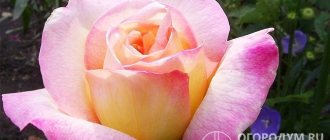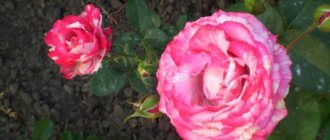Description of rose Augusta Louise
Rose Augusta Louise belongs to the hybrid tea group and is marked with the abbreviation (CH) on the packaging. However, in appearance it is more reminiscent of classic English or park varieties. This applies to both the plant itself and its characteristics.
If you believe the breeders, the rose can be grown in the sixth zone, if we talk about the official scale. It includes the southern regions of Russia, the Caucasus, and Crimea. However, the root system and shoots of the plant can withstand frosts up to 23 degrees. According to reviews from gardeners and photos of the Augusta Louise rose, it has taken root well in areas in the central and northwestern regions of the country.
Rose Augusta Louise forms low bushes, ranging from 1.0-1.2 m. The shoots are thick and strong, erect. Therefore, unlike park varieties, the plant looks compact and neat. The shoots themselves are dark green, sometimes with a brown tint. They are well leafed. Under favorable conditions during the flowering period, each of them ends in an inflorescence of 3 buds.
The leaves are large, ellipsoidal in shape and have finely serrated edges. A healthy plant has leaf blades that are dense, leathery, rich dark green in color with a pronounced glossy sheen. Even when at rest, the rose Augusta Louise serves as a decoration for park areas and garden plots.
Features of flowering
The plant forms its first buds a year after planting. According to the description, the rose variety Augusta Louise blooms in mid-June. Flowering lasts about 2-3 weeks. Then there is some lull, and closer to August a second wave of flowers appears.
Interesting fact!
Many gardeners from regions with mild climates and late onset of cold weather are talking about a third wave of flowering. Or they say that the rose Augusta Louise blooms almost continuously during June-October.
At the very beginning of flowering, the rose variety Augusta Louise forms buds similar to the buds of a hybrid tea rose. The same glass-shaped, sophisticated, with an indescribable play of all shades of pink. As it blooms, the situation changes. Delicate, trapezoidal petals with a wavy edge form an amazing double flower with a diameter of up to 10-12 cm. In the center the petals are twisted in a spiral, which gives it a special splendor and splendor. Reviews and descriptions of the Augusta Louise rose provided by gardeners say that each plant is unique at the moment of flowering. The buds of plants growing in fertile soils play with dark pink and salmon shades.
Origin details
The fact is that Augusta Louise von Stolberg was indeed a countess who at one time conducted a lively philosophical correspondence with Goethe himself. And when the 250th anniversary of the famous German poet was celebrated in 1999, his compatriot, the famous rose breeder Hans Jürgen Evers, a leading specialist at Tantau from Germany, presented his new creation under this name.
His “Countess” made a splash in the world of roses, over two decades managing to become one of the most popular varieties and win many international awards. Among the latter are the prize for the best aroma at an exhibition in New Zealand (2009) and the prize for the best hybrid tea rose in 2010.
Application in design
The variety is widely used in landscape design. The profusely and long-blooming rose Augusta Louise looks great in joint plantings with evergreens. It will set off the severity of thuja or juniper and add bright colors to a garden maintained in strict English traditions.
The plant can also be used in single plantings, as a bright accent in a recreation area or at the entrance to the house. But it is better if its root system is covered by green spaces. For example, hostas, feather grass or lavender. The variety is often used for planting along hedges. You can plant it with other roses that match the characteristics. The bright rose Augusta Louise and the snow-white shy Gentle Hermione look good together.
Planting and care
To grow Augusta Louise roses, choose well-lit places. It is advisable that she be in the sun in the morning and evening, and hid in light partial shade at noon. Whenever possible, try to protect the area from wind and drafts.
The soil selected is loose, well-drained, with plenty of nutrients, which will ensure abundant flowering of the rose and rich colors of its buds. Rose Augusta Louise grows well in neutral or slightly acidic soils. It is important that water does not stagnate at its roots.
The variety can be planted in September-October, about a month before the onset of frost. Or in early May, when positive night air temperatures set in. Prepare the hole in advance:
- Dig a hole 50-60 cm deep.
- A nutrient mixture is prepared from soil, compost and river sand.
- A small amount of crushed stone or expanded clay is poured onto the bottom.
- Lay a nutrient layer.
- Rose Augusta Louise seedlings are installed in such a way that the scion site is 5-6 cm below ground level.
The holes are closed, the root circle is watered, loosened and mulched with sawdust. Further care consists of:
- Regular watering in the evening.
- Fertilizing with nitrogen-containing compounds before flowering, and complex potassium-phosphorus fertilizers after each wave of flowering.
- Regular removal of faded buds.
In the fall, sanitary pruning is performed, removing all diseased, dried out shoots that do not form buds. In spring, beautiful bushes are formed and the stems are shortened to 30-40 cm.
Attention!
In warm autumn, the rose Augusta Louise has difficulty entering the dormant period. It can form buds before frost. In this case, they need to be cut off and the shoots shortened somewhat.
For the winter, fallen leaves, garbage, and old mulch are removed from under the bushes. Add compost or peat to the root circle and hill up the shoots to a height of 10-15 cm.
Plant Formation
Proper plant formation is vital for this rose variety. Not only will this increase flowering activity and speed, it will also encourage the development of new stems. Before you start caring for your bush, you need to correctly select all the required gardening tools and accessories. Among them, the following should be noted:
- A sharp knife for cleaning and straightening the cuts made.
- Secateurs for cutting thick branches.
- Saw for trimming unnecessary parts of the bush.
- Garden shears with a long handle for trimming shoots in hard-to-reach areas.
- Special protective gloves to avoid injury during work.
- Means for processing sections.
All instruments must be well maintained (processed and sharpened). This is required to prevent infection during work. Pruning and shaping of the plant can be done in the spring, summer and autumn seasons. The whole process differs depending on the time of year and has different objectives.
Treatment in spring
At this time of year, plants are pruned only to create a neat and attractive appearance of the bush. Formation is carried out in several stages:
- Produced after the end of frost and before bud formation. At the same time, all dry, diseased, damaged and broken stems are cut off. This sanitary procedure is mandatory to give the bush an attractive shape.
- Performed after the buds appear. This pruning is done to reduce the size of healthy branches to 30 cm. It is necessary to ensure that each shoot has at least two properly developing buds. Sections are made diagonally just above the kidneys. All treated areas must be disinfected with a special composition upon completion of work.
Pruning in the spring must be done annually. This allows you to give the plant a neat and correct appearance.
Summer pruning
Pruning a bush in summer can be different; it is done to achieve a specific task. This process affects the proper development and health of the rose, as well as its main decorative function. Pruning methods in the summer season:
- Formation of plants in the first year of life. First, after the formation of the true third leaf, pinching is performed. If everything is done correctly and in a timely manner, then young stems will soon appear on the shoot, which in the future will suffer the same fate. This procedure must be done before the beginning of August so that the bush can fully bloom. It is also necessary to deal with weak plants.
- Pruning of shoots that were not removed in spring, not flowering, diseased and weak shoots.
- Getting rid of wild growth. In bushes that have grafts, wild shoots begin to grow from the root system. If they are noticed, they need to be trimmed. This is not done in a visible area, but directly near the base of the stem. Otherwise, wild stems grow quickly, and this reduces the growth rate of the main shoot.
- Trimming dried flowers. This must be done continuously throughout the flowering period. Faded flowers are cut off simultaneously with 2-3 lower leaves 5 mm above the bud. Due to this, new shoots are formed, which will also begin to bloom very soon.
Autumn period
Preventive pruning in the fall is done before preparing the plant for wintering. As a rule, it is performed in October. All unblown inflorescences are cut off from the rose. In addition, green stems are removed from the bush, and woody stems are left. This is required to prevent the plant from rotting and dying under cover .
When pruning in the fall, you need to remove all dry and diseased shoots. Healthy branches need to be pruned to a height of about 30 cm. Autumn pruning will help strengthen it and make it possible to cover the plant more effectively. In winter it will feel much more comfortable and will easily withstand frost.
With the arrival of spring, the bush will begin to grow quickly and bloom luxuriantly. Any plant debris that appears after pruning is removed and burned. This will help you avoid various diseases.
Reviews from flower growers about the rose Augusta Louise
Olga, 34 years old, Krasnodar To be honest, the breeders got something wrong. Rose Augusta Louise is recommended for our locations. Not true. She just burns out. The buds fade as soon as they begin to bloom. The petals become like rags. Although it blooms all summer, I didn’t get any gorgeous bouquets.
Svetlana, 40 years old, Odintsovo Rosa Augusta Louise has become my favorite. Starts to bloom earlier than everyone else, finishes later. The big minus is her fear of rain. After a downpour, there are simply no flowers to bloom. Only petals. But it quickly recovers and forms new buds. The aroma is simply amazing. Neighbors say that it reminds them of summer holidays in Crimea or Bulgaria.











